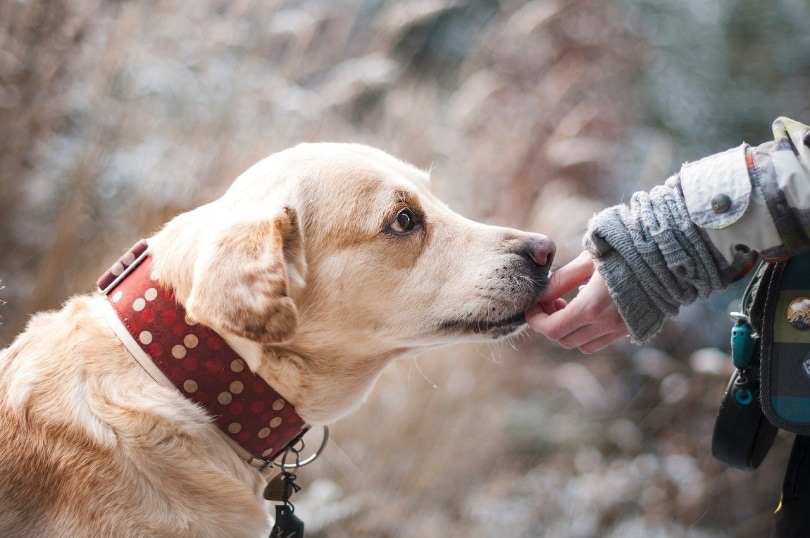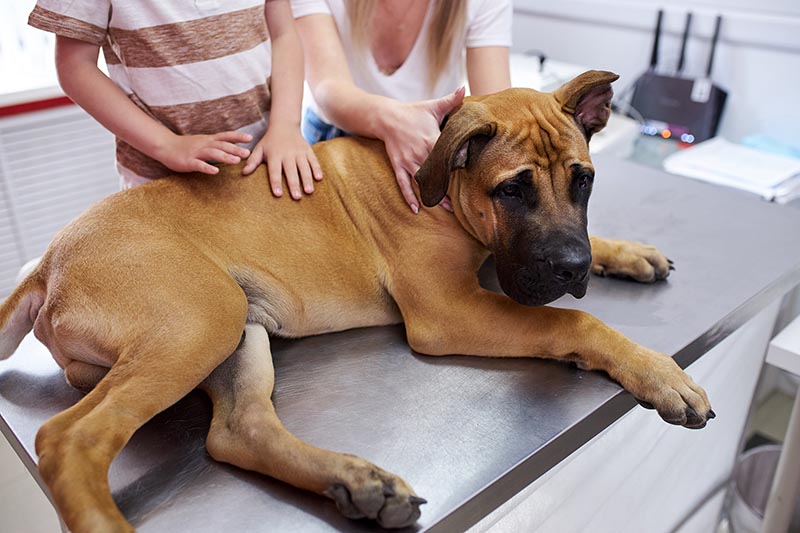Dogs tend to be happy-go-lucky creatures who live without a care in the world, so few things are more disconcerting than when your typically laid-back dog suddenly becomes anxious. Identifying the cause can be difficult, but it is doable with time and patience. If you can identify what might be causing your dog’s anxiety, you will have a good idea of where to start to help your dog feel safe and secure again.
Dogs can’t tell us how they’re feeling, so we’re left to use their behavior as a guide to help us determine how they’re feeling. Anxiety in dogs can be exhibited in a number of ways. If your dog has had any sudden changes in behavior, that is worth noting. If your dog has suddenly developed aggression, jumpiness, or fearfulness, that is extremely concerning. You may also see inappetence, excessive drooling or panting, inappropriate urination or defecation, lethargy or depression, pacing, excessive barking, trembling, hiding, and destructive behaviors.
The 9 Reasons Your Dog Is Anxious & How to Stop It
1. Fear

Just like humans, dogs can have fears and phobias. Maybe your dog is suddenly afraid of going through doorways. Has your dog’s tail been accidentally shut in the door recently? Your dog may have developed a fear of that doorway or doors in general. There are thousands of reasons your dog could have developed a fear of a specific situation, item, or person.
The Solution
Work to identify what your dog is fearful of. The more you can narrow down the list, the more likely you’ll be to find a realistic solution. How you deal with your dog’s fear will depend on what the fear is of, but no matter the cause, it’s your job to help your dog feel safe. Provide reassurance and positive reinforcement when your dog reacts positively. If needed, you can consult with a vet or a trainer for behavior modification tips.
Do you have an anxious dog? A high-quality, pet-safe CBD oil may be able to help. We like CBDfx's Pet Tincture, which comes in four different strength levels and is made from human-grade, organic hemp. Even better, your dog will love the natural bacon flavor!
2. Age
None of us like to think about our dogs aging, but it is an unfortunate truth. As dogs age, they can develop anxiety related to aging processes. The most common cause of this is Canine Cognitive Disorder, or CCD, which is similar to dementia in humans. Your dog may also begin to develop anxiety related to things that didn’t trigger anxiety before and may show alterations in social interactions or changes in the sleep-wake cycle.
The Solution
Be gentle and patient with your aging dog. Keeping your dog active physically and mentally can help stave off some aging processes and help keep your dog’s brain sharp. Keeping a routine and reading your dog’s body language will be key. Unfortunately, you can’t stop the aging process for your dog, but you can make it easier for them. A vet visit may be in order if you notice anxiety related to your dog’s age. There are medications, supplements, and therapies that can help dogs retain their dignity and comfort as they age.
3. Change

Some dogs are especially sensitive to changes within their environment. If you’re seeing signs of anxiety occurring in your dog, evaluate what may have changed in the environment recently. Some changes are obvious, like bringing home a new baby. Other changes may be less obvious to you, like new neighbors, road works, or home refurbishments, because those things don’t bother you.
The Solution
Identify the cause of the anxiety. If it’s a change that is easily corrected, like moving your dog’s bed back to a favorite spot, then that’s a simple step you can take to make your dog’s life easier. If it’s a more permanent change, like a baby, then you’ll have to work with your dog to understand boundaries. It’s important for you to continue to spend one-on-one time with your dog no matter the situation. Play, exercise, and spending time together can be reassuring to your dog and help them adjust to the new changes.
4. Weather
Animals are far more sensitive to changes in the weather than humans are. They can sense changes in barometric pressure and unusual smells from off in the distance, like rain. If your dog has become anxious in a period of hours or days, and unusual weather has occurred or is expected to occur, this could be the cause.
The Solution
There’s not much you can do about the weather. What you can do is reassure your dog, keep them busy, close windows and curtains, make sure they’re getting plenty of exercise and attention, and talk to your vet if this is a recurring problem. If your dog is fearful of thunderstorms, for example, then a Thundershirt, T-touch, supplements, or medications from your vet may be useful tools to make your dog feel safer.
5. Pain

Pain is the perfect example of dogs not being able to tell us how they’re feeling. Pain behaviors may be obvious, like limping. However, some dogs are more stoic and will grin and bear pain, so to speak. These dogs sometimes will show signs of anxiety, though. Aggression, jumpiness, hiding, depression, and inappetence are some of the most common signs dogs exhibit when they are stressed by pain.
The Solution
If your dog has developed any of the signs of anxiety previously mentioned, like aggression, hiding, or pacing, and you haven’t been successful in identifying an obvious cause of the anxiety, then follow up with your veterinarian and have your dog checked over. Your dog may have a long-term pain condition that is manageable, like arthritis, or your dog may have an acute pain problem, like an injury or certain cancers. Your vet will be able to narrow down the potential causes of pain and help you develop a treatment regimen for your dog.
6. Human Emotions Toward Others
Dogs are sensitive creatures, and they can pick up on our emotions. If you and your significant other have been fighting, your dog may be anxious because they can see your face and hear your tone of voice. Negative emotions don’t have to be directed toward your dog for your dog to feel anxious because of them.
The Solution
Reassurance and gentleness with your dog will help them recognize that you aren’t upset with them. Conflict between people isn’t always avoidable, so find ways to help your dog feel calmer when conflict occurs. Every dog is different and will appreciate different distractions.
7. Human Emotions Toward Them

Whether you’re upset with your dog because they chewed on your favorite shoes, or you think your dog is anxious about something, so you’re fretting over them, your dog can sense your emotions.
The Solution
It’s completely fine to show emotion toward your dog. In fact, it’s perfectly healthy. However, if your emotions are causing anxious behaviors, then you need to make adjustments to your own behaviors. Otherwise, you may end up in a cycle of your emotions, causing your dog to feel anxious, and the more anxious your dog seems, the more you worry over them, which just makes your dog more anxious.
8. Separation Anxiety
This is a very common form of anxiety in dogs, although it rarely just shows up out of the blue one day. Dogs with separation anxiety are commonly destructive, often breaking out of kennels, chewing holes in walls, and tearing up furniture. They may also be excessively loud, barking or howling the whole time they think they are alone.
The Solution
Separation anxiety should never be overlooked, and even though it may feel like a complex problem that is difficult to correct, you can help your dog in different ways. There is no one-size-fits-all approach to dealing with separation anxiety. If your dog is exhibiting signs of separation anxiety and you’re not having success with normal training methods, like changing your routine every time you leave or not making a big deal about arrivals or departures, then you should consult with your vet or a trainer for assistance. The earlier you begin correcting this problem, the more successful you’re likely to be in helping your dog.
9. Situational Anxiety

Sometimes, dogs will develop anxiety about highly specific situations. If your dog was attacked on a walk one time, for example, then it’s not uncommon for your dog to show signs of anxiety in the area where the attack occurred. Maybe there’s a yard you pass every day that has a dog that just drives your dog bonkers, so now your dog begins to get anxious when you turn on the same street as the house. Just like with fear, there are thousands of situations that can be anxiety-inducing for your dog.
The Solution
Once again, the best solution will be to identify the cause and begin working on that specific issue. There are so many things that could cause your dog to be anxious in certain situations that it’s impossible to give solid advice on how to fix it. Reassurance, positive reinforcement, training exercises, desensitization, dog trainers, and veterinarians can all be great starting points for correcting situational anxiety.
What If I Can’t Figure Out What’s Wrong?
If your dog is showing signs of anxiety but you can’t identify the cause, then the first thing you should do is have your dog checked over by the veterinarian. Even if your dog saw the vet two months ago, they still need to be seen. There are many things that can quickly change with your dog’s health or environment, and your vet is the best resource to helping you identify and correct the cause, whether it’s medical or behavioral.

 In Conclusion
In Conclusion
If your dog is showing signs of anxiety, you’re not alone. If you went door to door in your neighborhood and asked everyone what makes their dog anxious, they’d all give you a different answer. Whether it’s the dog down the street or the fireworks on the Fourth of July, identifying the cause of your dog’s anxiety is your best tool to help your dog feel safe and secure. A dog with anxiety is uncomfortable and doesn’t have an effective way to tell you, so paying close attention to your dog’s behaviors is a great way to stay on top of how your dog is feeling. Researching dog body language is another fantastic way to monitor your dog’s emotions.
- See also: 9 Dogs Prone to Anxiety (With Pictures)
Featured Image Credit: Isa KARAKUS, Pixabay






 In Conclusion
In Conclusion





